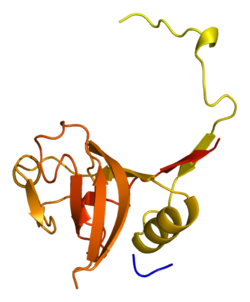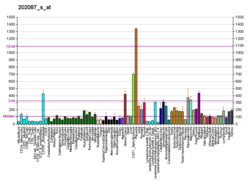Top Qs
Timeline
Chat
Perspective
Cathepsin L1
Protein-coding gene in the species Homo sapiens From Wikipedia, the free encyclopedia
Remove ads
Cathepsin L1 is a protein that in humans is encoded by the CTSL1 gene.[3][4][5] The protein is a cysteine cathepsin, a lysosomal cysteine protease that plays a major role in intracellular protein catabolism.[6][7][8][9]
Remove ads
Function
Summarize
Perspective
Cathepsin L1 is a member of the Peptidase C1 (cathepsin) MEROPS family, which plays an important role in diverse processes including normal lysosome mediated protein turnover, antigen and proprotein processing, and apoptosis.[10] Its substrates include collagen and elastin, as well as alpha-1 protease inhibitor, a major controlling element of neutrophil elastase activity. The encoded protein has been implicated in several pathologic processes, including myofibril necrosis in myopathies and in myocardial ischemia, and in the renal tubular response to proteinuria. This protein, which is a member of the peptidase C1 family, is a dimer composed of disulfide-linked heavy and light chains, both produced from a single protein precursor. At least two transcript variants encoding the same protein have been found for this gene.[5]
Viral entry
Cleavage of the SARS-CoV-2 S2 spike protein required for viral entry into cells can be accomplished by proteases TMPRSS2 located on the cell membrane, or by cathepsins (primarily cathepsin L) in endolysosomes.[11] Hydroxychloroquine inhibits the action of cathepsin L in endolysosomes, but because cathepsin L cleavage is minor compared to TMPRSS2 cleavage, hydroxychloroquine does little to inhibit SARS-CoV-2 infection.[11]
Inflammation
Although Cathepsin L is usually characterized as a lysosomal protease, it can be secreted, resulting in pathological inflammation.[12] Cathepsin L and other cysteine cathepsins tend to be secreted by macrophages and other tissue-invading immune cells when causing pathological inflammation.[13]
Remove ads
Interactions
CTSL1 has been shown to interact with Cystatin A.[14][15]
Distribution
Cathepsin L has been reported in many organisms including fish,[16] birds, mammals, and sponges.[17]
See also
- Cathepsin L2 (also known as cathepsin V)
References
Further reading
External links
Wikiwand - on
Seamless Wikipedia browsing. On steroids.
Remove ads




